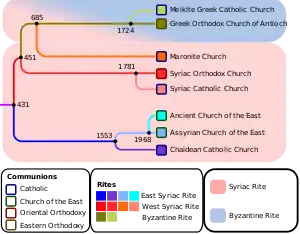Maronite Church
The Maronite Church is an Eastern Catholic sui iuris particular church in full communion with the pope and the worldwide Catholic Church, with self-governance under the Code of Canons of the Eastern Churches. It is headed by Patriarch Bechara Boutros al-Rahi since 2011, seated in Bkerke northeast of Beirut, Lebanon. Officially known as the Syriac Maronite Church of Antioch, it is part of Syriac Christianity by liturgy and heritage.
Syriac Maronite Church of Antioch | |
|---|---|
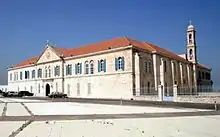 | |
| Classification | Eastern Catholic |
| Orientation | Syriac |
| Scripture | Peshitta[1][2] |
| Theology | Catholic theology |
| Polity | Episcopal |
| Governance | Holy Synod of the Maronite Church[3] |
| Pope | Francis |
| Patriarch[4][5] | Bechara Boutros al-Rahi |
| First autocephalous Patriarch | St. John Maron |
| Region | Lebanon (approximately one third), Syria, Israel, Cyprus, Jordan, and diaspora |
| Language | Arabic (Lebanese Arabic · Cypriot Maronite Arabic); Liturgical:Arabic,[6][7] Aramaic (Syriac) |
| Liturgy | West Syriac Rite |
| Headquarters | Bkerké, Lebanon |
| Founder | Maron; John Maron |
| Origin | 410 AD Monastery of Saint Maron, Phoenicia, Roman Empire |
| Members | 3,498,707[8] |
| Official website | http://www.bkerki.org |
| Logo | |
| Part of a series on |
| Maronite Church |
|---|
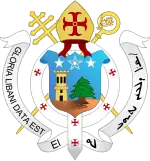 |
| Patriarchate |
| Religious orders and societies |
| Communities |
| Languages |
| History |
| Related politics |
|
|
| Part of a series on |
| Particular churches sui iuris of the Catholic Church |
|---|
| Particular churches are grouped by rite. |
| Alexandrian Rite |
| Armenian Rite |
| Byzantine Rite |
| East Syriac Rite |
| Latin liturgical rites |
| West Syriac Rite |
|
|
Establishment of the Maronite Church can be divided into three periods, from the 4th to the 7th centuries. A congregation movement, with Saint Maroun from the Taurus Mountains as an inspirational leader and patron saint, marked the first period. The second began with the establishment of the Monastery of Saint Maroun on the Orontes, built after the Council of Chalcedon to defend the doctrines of the council.[9] This monastery was described as the "greatest monastery" in the region of Secunda Syria, with more than 300 hermitages around it, according to ancient records.[10] After 518, the monastery de facto administered many parishes in Prima Syria, Cole Syria and Phoenicia. The third period was when Sede Vacante followed the Islamic conquest of the region and bishops of the Saint Maroun Monastery elected John Maron as Patriarch circa 685 AD, according to Maronite tradition. The Greek Orthodox Church of Antioch reestablished their patriarchate in 751 AD.[11] Other centers of historical importance include Kfarhay, Yanouh, Mayfouq, and the Qadisha Valley.
Although reduced in numbers today, Maronites remain one of the principal ethno-religious groups in Lebanon, with smaller minorities of Maronites in Syria, Cyprus, Israel, and Jordan. Emigration since the 19th century means that about two-thirds of its three million members[12] are located outside "The Antiochian's Range", where they are part of the worldwide Lebanese diaspora.
Name
The Maronite Church (Arabic: الكنيسة المارونية) is officially known as the Syriac Maronite Church of Antioch (Latin: Ecclesia Syrorum Maronitarum; Classical Syriac: ܥܕܬܐ ܣܘܪܝܝܬܐ ܡܪܘܢܝܬܐ ܕܐܢܛܝܘܟܝܐ, romanized: ʿĪḏto Suryoyṯo Morunoyṯo d'Anṭiokia; Arabic: الكنيسة الأنطاكية السريانية المارونية al-Kanīsa al-Anṭākiyya al-Suryāniyya al-Mārūniyya).
Overview
St Maroun is considered the founder of the spiritual and monastic movement now called the Maronite Church. This movement has had a profound influence in Lebanon, and to a lesser degree in Syria, Jordan and Palestine. Saint Maroun spent his life on a mountain in Syria, generally believed to be "Kefar-Nabo" on the mountain of Ol-Yambos in the Taurus Mountains, contemporary Turkey, becoming the cradle of the Maronite movement established in the Monastery of Saint Maron.
The six major traditions of the Catholic Church are Alexandrian, Antiochene, Armenian, Chaldean, Constantinopolitan (Byzantine), and Latin (Roman). The Maronite Church follows the Antiochene Tradition.[13] A Roman Catholic may attend any Eastern Catholic Liturgy and fulfill his or her obligations at an Eastern Catholic Parish. That is, a Roman Catholic may join any Eastern Catholic Parish and receive any sacrament from an Eastern Catholic priest since all belong to the Catholic Church.[14] Maronites who do not reside within a convenient distance to a local Maronite Church are permitted to attend other Catholic churches while retaining their Maronite membership.[15]
The Maronite Patriarchal Assembly (2003–2004) identified five distinguishing marks of the Maronite Church:
- It is Antiochene.
- It is Chalcedonian, in that the Maronites were strong supporters of the Council of Chalcedon of 451.
- It is Patriarchal and Monastic.
- It is faithful to the See of Peter in Rome.
- It has strong ties to Lebanon.[13]
History
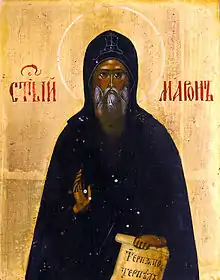
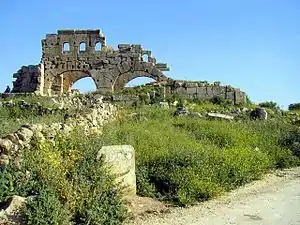
Saint Maron, a fourth-century monk and a contemporary and friend of St. John Chrysostom, left Antioch for the Orontes River in modern-day Syria to lead an ascetic life, following the traditions of Anthony the Great of the Desert and of Pachomius. Many of his followers also lived a monastic lifestyle.
Following Maron's death in 410 AD, his disciples built Beth-Maron monastery at Apamea (present day Qalaat al-Madiq). This formed the nucleus of the Maronite Church. In 452, after the Council of Chalcedon, the monastery was expanded by the Byzantine emperor Marcian.[16]
The Maronite movement reached Lebanon when St. Maron's first disciple, Abraham of Cyrrhus, who was called the "Apostle of Lebanon", set out to convert the non-Christians by introducing them to St. Maron.[12]
The Maronites subscribed to the beliefs of the Council of Chalcedon in 451. Monophysites of Antioch slew 350 monks and burned the monastery, although Justinian I later restored the walls. Correspondence concerning the event brought the Maronites papal and orthodox recognition, indicated by a letter from Pope Hormisdas (514–523) dated 10 February 518.[17] Representatives from Beth-Maron participated in the Constantinople synods of 536 and 553.
An outbreak of civil war during the reign of Emperor Phocas brought forth riots in the cities of Syria and Palestine and incursions by Persian King Khosrow II. In 609, the Patriarch of Antioch, Anastasius II, was killed either at the hands of some soldiers or locals.[18] This left the Maronites without a leader, which continued because of the final Byzantine–Sassanid War of 602–628.
In the aftermath of the war, the Emperor Heraclius propagated a new Christological doctrine in an attempt to unify the various Christian churches of the East, who were divided over accepting the Council of Chalcedon. This doctrine, the unity of Christ's will with God's, was meant as a compromise between supporters of Chalcedon, such as the Maronites, and opponents, such as the Jacobites. The doctrine was endorsed by Pope Honorius I to win back the Monophysites but problems soon arose (see his anathematization).
Instead, the unity of Christ's will with God's (mia-thelitism) was misunderstood as Monothelitism (that Christ and God have only one will) which caused even greater controversy, and was declared a heresy at the Third Council of Constantinople in 680–681. The Council condemned both Honorius and Patriarch Sergius I of Constantinople but did not mention the Maronites.[16]
Contemporary Greek and Arab sources misrepresented the miathelite Maronites as having rejected the third council and accepted monothelitism,[19] and that the miathelites in fact maintained monothelitism for centuries, only moving away from it in the time of the crusades in order to avoid being branded heretics by the crusaders. The Maronite Church, however, rejects the assertion that the Maronites were ever monothelites or apart from the Roman Catholic Church;[20] and the question remains a matter of controversy.[19] Elias El-Hāyek attributes much of the confusion to Eutyches of Alexandria, whose Annals contain erroneous material regarding the early Maronite Church, which was then picked up by William of Tyre and others.[16]
During the start of the patriarchs' period, the persecution of Christians and Arabization of the region, including the destruction of the Monastery of Saint Maron, led the majority of the Maronites to move to the barren mountains of Lebanon, especially the northern territory. They established a closed, rural, hierarchical society; reestablished communication with the Papacy during the Crusades; maintained Syriac language up to the 18th century, but eventually and shifted to Lebanese Arabic as their native language. They issued many liturgical reforms, most notably during Qannoubin's council of 1580, and the Lebanese council of 1736 – which seems in many parts to be a Latinization- gained protection from the Monarchy of France for the church and its community. They organized the monastery in 1696. They played an influential role in Lebanon's political scene especially after 1770, when the Chehab dynasty joined the Maronite Church. That choice was an essential element of the creation of Greater Lebanon in 1920, seen widely by scholars as fulfillment of the Maronites' desire. However, due to mass emigration and eventually the Lebanese Civil War (1975–1990), the Maronite role in the Second Lebanese Republic declined.
First Maronite Patriarch
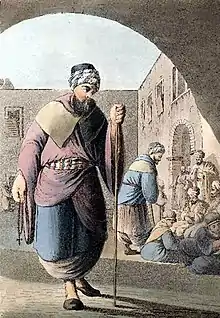
The Patriarch of Antioch Anastasius II died in 609, and Constantinople began to appoint a series of titular patriarchs, who resided in Constantinople. In 685, the Maronites elected Bishop John Maron of Batroun as Patriarch of Antioch and all the East.[16] Through him, later Maronites claimed full apostolic succession through the Patriarchal See of Antioch. While this installation of a patriarch was seen as a usurpation by the Orthodox hierarchy, John received the approval of Pope Sergius I, and became the first Maronite Patriarch of the oldest see in Christianity.
In 687, as part of an agreements with Abd al-Malik ibn Marwan, Byzantine emperor Justinian II sent 12,000 Christian Maronites from Lebanon to Armenia,[21] in exchange for a substantial payment and half the revenues of Cyprus.[16] There they were conscripted as rowers and marines in the Byzantine navy.[22] Additional resettlement efforts allowed Justinian to reinforce naval forces depleted by earlier conflicts.[23] The Maronites struggled to retain their autonomy against both imperial power and Arab incursions on the part of the Damascus Caliphate.
Maron established himself in the remote Qadisha Valley in Lebanon. In 694, Justinian sent troops against the Maronites in an unsuccessful attempt to capture the Patriarch.[24] Maron died in 707 at the Monastery of St. Maron in Lebanon. Around 749 the Maronite community, in the Lebanon mountains, built the Mar-Mama church at Ehden. Meanwhile, caught between the Byzantines and the Arabs, the monastery at Beth-Maron struggled to survive.[25]
Islamic rule
After they came under Arab rule following the Muslim conquest of Syria (634–638), Maronite immigration to Lebanon, which had begun some time before, increased, intensifying under the Abbasid caliph al-Ma'mun (813–33).[24] The Maronites experienced an improvement in their relationship with the Byzantine Empire. Emperor Constantine IV (reigned 668–685) provided direct ecclesiastical, political and military support to the Maronites. The new alliance coordinated devastating raids on Muslim forces, providing a welcome relief to besieged Christians throughout the Middle East.
During this period the region was dominated by the Abbasids, who persecuted the Maronites. Around AD 1017, a new Muslim sect, the Druze, emerged. At that time the Maronites, as dhimmis, were required to wear black robes and black turbans and they were forbidden to ride horses.
To eliminate internal dissent, from 1289 to 1291 Egyptian Mamluk troops descended on Mount Lebanon, destroying forts and monasteries.[26]
Crusades
Following the Muslim conquest of Eastern Christendom outside Anatolia and Europe in the 7th century and after the establishment of secured lines of demarcation between Islamic Caliphs and Byzantine Emperors, little was heard from the Maronites for 400 years. Secure in their mountain strongholds, the Maronites were re-discovered in the mountains near Tripoli, Lebanon, by Raymond of Toulouse on his way to conquer Jerusalem in the Great Crusade of 1096–1099. Raymond later returned to besiege Tripoli (1102–1109) after the conquest of Jerusalem in 1099, and relations between the Maronites and European Christianity were subsequently reestablished.[27]
The Maronites assisted the crusaders and affirmed their affiliation with the Holy See of Rome in 1182.[28] To commemorate their communion, Maronite Patriarch Youseff Al Jirjisi received the crown and staff, marking his patriarchal authority, from Pope Paschal II in 1100 AD. In 1131, Maronite Patriarch Gregorios Al-Halati received letters from Pope Innocent II in which the Papacy recognized the authority of the Patriarchate of Antioch. Patriarch Jeremias II Al-Amshitti (1199–1230) became the first Maronite Patriarch to visit Rome when he attended the Fourth Council of the Lateran in 1215.[28] The Patriarchate of Antioch was also represented at the Council of Ferrara in 1438.[29]
Peter Hans Kolvenbach notes, "This contact with the Latin Church enriched the intellectual world of Europe in the Middle Ages. Maronites taught Oriental languages and literature at the universities of Italy and France."[25]
Ottoman rule
In the Ottoman Empire, indigenous concentrated religious communities dealt mainly with the provincial administration. Officially, Maronites had to pay the jizya tax as non-Muslims, but sometimes the monks and clergy were exempt because they were considered to be "poor".[30]
Fakhr-al-Din II (1572 – 1635) was a Druze prince and a leader of the Emirate of Chouf District in the governorate of Mount Lebanon. Maronite Abū Nādir al-Khāzin was one of his foremost supporters and served as Fakhr-al-Din's adjutant. Phares notes that "The emirs prospered from the intellectual skills and trading talents of the Maronites, while the Christians gained political protection, autonomy and a local ally against the ever-present threat of direct Ottoman rule."[31] In 1649, Patriarch Yuhanna al-Sufrari placed the Maronites under French protection, and the French opened a consulate in Beirut.[32]
The Khāzin sheikhs subsequently increased in power and influence. In 1662, with the mediation of Jesuit missionaries, Abū Nawfal al-Khāzin was named French consul, despite complaints by Marseille merchants that he wasn't from Marseille.[30] The Church prospered from the protection and influence of the Khāzins, but at the expense of interference in church affairs, particularly ecclesiastical appointments, which the Khāzins saw as an extension of their political influence.[31]
In 1610, the Maronite monks of the Monastery of Saint Anthony of Qozhaya imported one of the first printing presses in the Arabic-speaking world; however, that press printed in the Syriac language, not Arabic. The monasteries of Lebanon later became key players in the Arabic Renaissance of the late 19th century as a result of developing Arabic, as well as Syriac, printable script.
Bachir Chehab II was the first and last Maronite ruler of the Emirate of Mount Lebanon.[33] A convert from Sunni Islam, his rivalry with the Druze leader Bashir Jumblatt caused tension between the two communities. In the 1822 war between Damascus and Acre, they backed opposite sides.
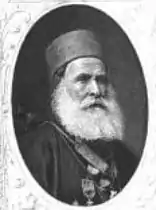
The relationship between the Druze and Christians has been characterized by harmony and coexistence,[34][35][36][37] with amicable relations between the two groups prevailing throughout history, with the exception of some periods, including 1860 Mount Lebanon civil war.[38][39] In the spring of 1860, war broke out between the Druze population and the Maronite Christians. The Ottoman authorities in Lebanon could not stop the violence and it spread into neighboring Syria, with the massacre of many Christians. In Damascus, the Emir Abd-el-Kadr protected the Christians there against the Muslim rioters.
French emperor Napoleon III felt obliged to intervene on behalf of the Christians, despite London's opposition, which feared it would lead to a wider French presence in the Middle East. After arduous negotiations to obtain the approval of the British government, Napoleon III sent a French contingent of seven thousand men for a period of six months. The troops arrived in Beirut in August 1860 and took positions in the mountains between the Christian and Muslim communities. He then organized an international conference in Paris, where the country was placed under the rule of a Christian governor named by the Ottoman Sultan, which restored a fragile peace.
French rule
Independent Lebanon
Synod of Mount Lebanon (1736)
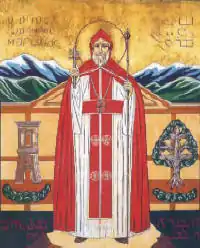
Maronite orientalist Joseph Simon Assemani presided as papal legate for Pope Clement XII. The synod drafted a Code of Canons for the Maronite Church and created the first regular diocesan structure.[28] The Council of Luwayza led to a more effective church structure and to gradual emancipation from the influence of Maronite families.[40] Education was declared a major task. Through the joint efforts of the Church and French Jesuits, literacy became widespread.
Latinization
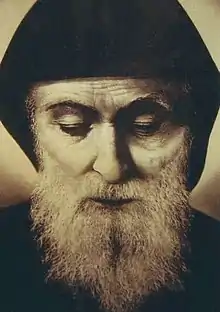
Due to closer ties with the Latin Church, the Maronite Church is among the most Latinized of the Eastern Catholic Churches, although there have been moves to return to Eastern practices.
Contacts between the Maronite monks and Rome date to the 5th century and were revived during the Crusades. The Maronites introduced to Eastern Churches Western devotional practices such as the rosary and the Stations of the Cross.[25] Late in the 16th century, Pope Gregory XIII sent Jesuits to the Lebanese monasteries to ensure that their practice conformed to decisions made at the Council of Trent.[26] The Maronite College in Rome was established by Gregory XIII in 1584.[31] The Maronite missal (Qurbono) was first printed between 1592 and 1594 in Rome, although with fewer anaphoras. The venerable Anaphora (Eucharistic Prayer) Sharrar, attributed to St. Peter, was eliminated from later editions.
Patriarch Stephan al-Duwayhî (1670–1704), (later declared a "Servant of God"), was able to find a middle ground between reformers and conservatives, and re-vitalized Maronite liturgical tradition.[29]
The Synod of Mount Lebanon sought to incorporate both traditions. It formalized many of the Latin practices that had developed, but also attempted to preserve ancient Maronite liturgical tradition. The Synod did not sanction the exclusive use of the Roman ritual in the administration of Baptism. However, in the Eastern tradition, the oil of catechumens is blessed by the priest during the baptismal rite. This blessing was now reserved to the Chrism Mass of Holy Thursday. A practice common among all the Eastern Churches is to administer Baptism and First Communion together. As in the Latin Rite Holy Communion is to be given only to those who have attained the age of reason; priests were forbidden to give Communion to infants.[41]
In Orientale lumen, the Apostolic Letter to the Churches of the East, issued 2 May 1995, Pope John Paul II quotes Orientalium Ecclesiarum, the Second Vatican Council's Decree on the Eastern Catholic Churches:
It has been stressed several times that the full union of the Catholic Eastern Churches with the Church of Rome which has already been achieved must not imply a diminished awareness of their own authenticity and originality. Wherever this occurred, the Second Vatican Council has urged them to rediscover their full identity, because they have "the right and the duty to govern themselves according to their own unique disciplines. For these are guaranteed by ancient tradition and seem to be better suited to the customs of their faithful and to the good of their souls."[42]
Cardinal Sfeir's personal commitment accelerated liturgical reforms in the 1980s and 1990s. In 1992 he published a new Maronite Missal.[29] This represents an attempt to return to the original form of the Antiochene Liturgy, removing the liturgical Latinization of past centuries. The Service of the Word has been described as far more enriched than in previous missals, and there are six Anaphoras.
Patriarch Sfeir stated that Sacrosanctum concilium and the Roman liturgical changes following Vatican II apply to the Maronite Church. Sancrosanctum Concilium says, "Among these principles and norms there are some which can and should be applied both to the Roman rite and also to all the other rites. The practical norms which follow, however, should be taken as applying only to the Roman rite, except for those which, in the very nature of things, affect other rites as well."[43]
Organization
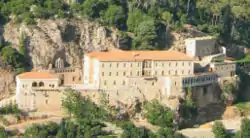
Patriarchate of Antioch
The head of the Maronite Church is the Patriarch of Antioch and the Whole Levant, who is elected by the Maronite bishops and resides in Bkerké, close to Jounieh, north of Beirut. He resides in the northern town of Dimane during the summer.[13]
There are four other claimants to the Patriarchal succession of Antioch:
- two other Eastern Catholic, also in full communion with the Papal Holy See of Rome :
- two Orthodox :
- Eastern Orthodox Church, the Greek Orthodox Patriarch of Antioch and All the East, of the Antiochian Orthodox Church, in communion with the Ecumenical Patriarch of Constantinople
- Oriental Orthodoxy, the Patriarch of Antioch and All the East, Supreme Head of the Syriac Orthodox Church
The Maronite Patriarch of Antioch and the Whole Levant since March 2011 is Bechara Boutros Rahi. When a new Patriarch is elected and enthroned, he requests ecclesiastical recognition by the Pope, thus maintaining communion with the Holy See. As an Eastern Catholic Patriarch, the Patriarch is usually created a Cardinal by the Pope in the rank of a Cardinal Bishop; he does however not receive a suburbicarian see (required to become Dean), even ranks below those six, but is known by the title of the patriarchate of his sui iuris Church.
Clerical celibacy is not strictly required for Maronite deacons and priests of parishes outside of North America; monks, however, must remain celibate, as well as bishops who are normally selected from the monasteries. Due to a long-term understanding with their Latin counterparts in North America, Maronite priests in that area have traditionally remained celibate. However, in February 2014, Wissam Akiki was ordained to the priesthood by Bishop A. Elias Zaidan of the U.S. Maronite Eparchy of Our Lady of Lebanon at St. Raymond's Maronite Cathedral in St. Louis. Deacon Akiki is the first married man to be ordained to the Maronite priesthood in North America and will not be expected to uphold a vow of celibacy.[44]
Dioceses
Despite the many archiepiscopates, none is a Metropolitan abstraction made of the Patriarch of Antioch, who has a single Suffragan (Jebbeh–Sarba–Jounieh) and hence an ecclesiastical province. In Latin America, two Maronite eparchies are suffragans of Latin metropolitans.
The Maronite church has twenty-six eparchies and patriarchal vicariates as follows:[45]
Middle East
- Worldwide Immediately subject to the Patriarch
- In Lebanon:
- Maronite Catholic Archeparchy of Antelias
- Maronite Catholic Eparchy of Baalbek-Deir El Ahmar
- Maronite Catholic Eparchy of Batroun
- Maronite Catholic Archeparchy of Beirut
- Maronite Catholic Eparchy of Jbeil
- Maronite Catholic Eparchy of Joubbé, Sarba and Jounieh (sole Suffragan of the Patriarch of Antioch)
- Maronite Catholic Eparchy of Sidon
- Maronite Catholic Archeparchy of Tripoli
- Maronite Catholic Archeparchy of Tyre
- Maronite Catholic Eparchy of Zahleh
- In the Holy Land:
- Maronite Catholic Archeparchy of Haifa and the Holy Land, in Israel whose Archeparch holds the offices of Patriarchal Vicar of:
- Patriarchal Exarch of the Maronite Catholic Patriarchal Exarchate of Jerusalem and Palestine in the Palestinian Territories and
- Maronite Catholic Patriarchal Exarchate of Jordan in (Trans)Jordan
- Maronite Catholic Archeparchy of Haifa and the Holy Land, in Israel whose Archeparch holds the offices of Patriarchal Vicar of:
- In Syria:
- In Cyprus: Maronite Catholic Archeparchy of Cyprus in Nicosia
- In Egypt: Maronite Catholic Eparchy of Cairo
Elsewhere
- Exempt, i.e. immediately subject to the Holy See:
- In Africa: Maronite Catholic Eparchy of Annunciation of Ibadan, with cathedral see being Church of Our Lady of the Annunciation, in Ibadan, in Nigeria
- In South America: Maronite Catholic Apostolic Exarchate of Colombia, with pro-cathedral see being Church of Our Lady of Lebanon, in Bogotá, in Colombia
- Subject to the Synod in matters of liturgical and particular law, otherwise exempt, i.e. immediately subject to the Holy See and its Roman Congregation for the Eastern Churches:
- In Europe:
- In North and Central America:
- Maronite Catholic Eparchy of Saint Maron of Montreal, in Canada
- Maronite Catholic Eparchy of Our Lady of Lebanon of Los Angeles in the United States[46] (Central US, US West Coast)
- Maronite Catholic Eparchy of Saint Maron of Brooklyn in the United States[47] (US East Coast)
- Maronite Catholic Eparchy of Our Lady of the Martyrs of Lebanon in Mexico in Mexico
- In Oceania:
- Suffragan Eparchies in the ecclesiastical provinces of Latin Metropolitan Archbishops; both in South America:
- Maronite Catholic Eparchy of San Charbel in Buenos Aires in Argentina, suffragan of the Roman Catholic Archdiocese of Buenos Aires
- Maronite Catholic Eparchy of Our Lady of Lebanon of São Paulo in Brazil, suffragan of the Roman Catholic Archdiocese of São Paulo
Titular sees
- Four Titular archbishoprics (none Metropolitan): Cyrrhus of the Maronites, Laodicea in Syria of the Maronites, Nazareth of the Maronites, Nisibis of the Maronites
- Nine Titular bishoprics : Apamea in Syria of the Maronites, Arca in Armenia of the Maronites, Arca in Phoenicia of the Maronites, Callinicum of the Maronites, Epiphania in Syria of the Maronites, Hemesa of the Maronites, Ptolemais in Phœnicia of the Maronites, Sarepta of the Maronites, Tarsus of the Maronites.
Religious institutes (orders)
Population
The global Maronite population is not exactly known, but is estimated at more than 3 million, according to the Catholic Near East Welfare Association.
According to the official site of the maronite church, approximately 1,062,000 Maronites live in Lebanon, where they constitute up to 22 -23 percent of the population. Syrian Maronites total 51,000, following the archdioceses of Aleppo and Damascus and the Diocese of Latakia.[52] A Maronite community of about 10,000 lives in Cyprus[52] that speaks Cypriot Maronite Arabic.[53][54] A noticeable Maronite community exists in northern Israel (Galilee), numbering 7,504,[52] famous for its preservation attempts of the Aramaic language and Aramean ethnic identity.
Diaspora
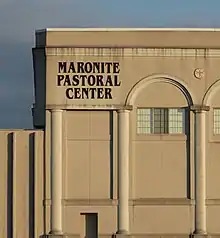
Immigration of Maronite faithful from the Middle East to the United States began during the latter part of the nineteenth century. When the faithful were able to obtain a priest, communities were established as parishes under the jurisdiction of the local Latin bishops. In January 1966, Pope Paul VI established the Maronite Apostolic Exarchate for the Maronite faithful of the United States. In a decree of the Sacred Congregation for the Eastern Churches, Bishop Francis Mansour Zayek was appointed the first exarch. The see, in Detroit, Michigan, with a cathedral under the patronage of Saint Maron, was suffragan to the Archdiocese of Detroit. In 1971, Pope Paul VI elevated the Exarchate to the status of an Eparchy, with the name of Eparchy of Saint Maron of Detroit. In 1977, the see of the Eparchy of Saint Maron was transferred to Brooklyn, New York, with the cathedral under the patronage of Our Lady of Lebanon. The name of the Eparchy was modified to Eparchy of Saint Maron of Brooklyn.[15]
In 1994, the Eparchy of Our Lady of Lebanon was established with the cathedral at Los Angeles, California, under the patronage of Our Lady of Lebanon.[15] John George Chedid, auxiliary bishop of the Diocese of Saint Maron of Brooklyn, was ordained as the first Bishop of the Maronite Catholic Eparchy of Our Lady of Lebanon of Los Angeles at the Our Lady of Lebanon Cathedral in Los Angeles, California, where he served until he reached the mandatory retirement age of 80. In December 2000, Robert Joseph Shaheen succeeded Chedid as eparch.
The two eparchies in the United States have issued their own "Maronite Census," designed to estimate the population of Maronites in the United States. Many have been assimilated into Western Catholicism absent Maronite parishes or priests. The "Maronite Census" was designed to locate these Maronites.
Eparchies operate in São Paulo in Brazil, as well as in Colombia, México, France, Australia,[55] South Africa, Canada and Argentina.[52]
Former Brazilian president Michel Temer, the first Arab-Brazilian to have led the nation, was the son of two Maronite Catholic Lebanese immigrants
The history of the Lebanese community in South Africa dates to the late 19th century, when the first immigrants arrived in Johannesburg, the biggest city in the Transvaal, having come from Sebhel, Mesyara, Becharre, Hadath El Jebbeh, Maghdouché and other places. It is recorded that in 1896, the first Maronite and Lebanese immigrants arrived in Durban, Cape Town, and Mozambique, and congregated around their local Catholic churches.
Other
See also
References
- Assemani, Maronite Light from the East for the Church and the World
- Studia Humana Volume 2:3 (2013), pp. 53—55
- Synod of the Maronite Church Patriarchal Synod
- Cardinal Nasrallah Boutros Sfeir, head of the Maronite Church who steered a difficult course between factions in the Middle East – obituary
- Maronite patriarch elevates St. Maron pastor to chorbishop during Detroit visit
- Maronite liturgy draws from Eastern and Western traditions, Catholics and cultures
- The Maronite Divine Liturgy, By Dr Margaret Ghosn, Our Lady of Lebanon parish Australia
- "Archived copy" (PDF). Archived from the original (PDF) on 24 October 2018. Retrieved 15 October 2019.CS1 maint: archived copy as title (link)
- History of the Maronites, Maronite Heritage.com, 13 April 2016.
- Beggiani, Seely. "Aspects of Maronite History—Monastery of St. Maron". Eparchy of Saint Maron of Brooklyn. Archived from the original on 2 March 2001. Retrieved 4 July 2017.
- No'man 1996, p. 22.
- "There are 3,198,600 Maronites in the World". Maronite-heritage.com. 3 January 1994. Retrieved 3 January 2015.
- "Maronite Church". Retrieved 16 June 2016.
- "About the Maronite Rite - Our Lady's Maronite Catholic Church". Archived from the original on 25 May 2016. Retrieved 16 June 2016.
- "MARONITE HISTORY & SAINT MARON - St. Anthony Maronite Catholic Church". Retrieved 16 June 2016.
- Conversion and Continuity. 1990. ISBN 9780888448095 – via books.google.com.
- Attwater, Donald; The Christian Churches of the East
- Frendo, J. D. (1982). "Who Killed Anastasius II?". The Jewish Quarterly Review. 72 (3): 202–204. doi:10.2307/1454219. JSTOR 1454219.
- Moosa 1986, pp. 195–216.
- "The Story of the Maronite Catholics - The Maronite Monks of Adoration". Retrieved 16 June 2016.
- Bury, J.B., A History of the Later Roman Empire from Arcadius to Irene, Vol. II, MacMillan & Co., 1889, p. 321
- Treadgold, Warren T., Byzantium and Its Army, 284–1081, 1998, Stanford University Press, p. 72, ISBN 0-8047-3163-2,
- Ostrogorsky, George, History of the Byzantine state, (Joan Hussey, trans.), 1957, Rutgers University Press, pp. 116–122, ISBN 0-8135-0599-2
- "PureHost". www.stmaron.org. Archived from the original on 20 May 2015.
- "Maronites Between Two Worlds – Eparchy of Saint Maron of Brooklyn". www.stmaron.org. Retrieved 18 August 2018.
- Johnston, William M. (4 December 2013). Encyclopedia of Monasticism. Routledge. ISBN 9781136787164 – via Google Books.
- "THE EASTERN CHRISTIAN CHURCHES". www.maryourmother.net.
- "CNEWA - The Maronite Catholic Church". Retrieved 16 June 2016.
- Wainwright, Geoffrey (23 March 2006). The Oxford History of Christian Worship. Oxford University Press, USA. ISBN 9780195138863 – via Google Books.
- Leeuwen, Richard Van (23 March 1994). Notables and Clergy in Mount Lebanon: The Khāzin Sheikhs and the Maronite Church, 1736-1840. BRILL. ISBN 9004099786 – via Google Books.
- O'Mahony, Anthony; Loosley, Emma (16 December 2009). Eastern Christianity in the Modern Middle East. Routledge. ISBN 9781135193713 – via Google Books.
- Phan, Peter C. (21 January 2011). Christianities in Asia. John Wiley & Sons. ISBN 9781444392609 – via Google Books.
- Moosa 1986, p. 283.
- Hazran, Yusri (2013). The Druze Community and the Lebanese State: Between Confrontation and Reconciliation. Routledge. p. 32. ISBN 9781317931737.
the Druze had been able to live in harmony with the Christian
- Artzi, Pinḥas (1984). Confrontation and Coexistence. Bar-Ilan University Press. p. 166. ISBN 9789652260499.
.. Europeans who visited the area during this period related that the Druze "love the Christians more than the other believers," and that they "hate the Turks, the Muslims and the Arabs [Bedouin] with an intense hatred.
- CHURCHILL (1862). The Druzes and the Maronites. Montserrat Abbey Library. p. 25.
..the Druzes and Christians lived together in the most perfect harmony and good-will..
- Hobby (1985). Near East/South Asia Report. Foreign Broadcast Information Service. p. 53.
the Druzes and the Christians in the Shuf Mountains in the past lived in complete harmony..
- Fawaz, L.T. (1994). An Occasion for War: Civil Conflict in Lebanon and Damascus in 1860. University of California Press. ISBN 9780520087828. Retrieved 16 April 2015.
- Vocke, Harald (1978). The Lebanese war: its origins and political dimensions. C. Hurst. p. 10. ISBN 0-903983-92-3.
- Hakim, Carol (19 January 2013). The Origins of the Lebanese National Idea: 1840–1920. University of California Press. ISBN 9780520954717 – via Google Books.
- "PureHost". www.stmaron.org. Archived from the original on 20 May 2014.
- "CIN - Orientale Lumen Pope John Paul II". www.cin.org.
- "Sacrosanctum concilium". www.vatican.va. Archived from the original on 21 February 2008.
- "First married man ordained priest for U.S. Maronite Catholic Church". National Catholic Reporter. 28 February 2014. Retrieved 18 August 2018.
- Church website Archived 23 July 2011 at the Wayback Machine, accessed 20 March 2011
- Soumen. "MARONITE EPARCHY OF OUR LADY OF LOS ANGELES". Retrieved 16 June 2016.
- "Eparchy of Saint Maron of Brooklyn". Retrieved 16 June 2016.
- "Home". Retrieved 16 June 2016.
- "OAM - Accueil". Retrieved 16 June 2016.
- Mariamite Maronite Order (O.M.M.) Archived 28 January 2016 at the Wayback Machine Arabic
- "Congregation Of Maronite Lebanese Missionaries". Retrieved 16 June 2016.
- Annuario Pontificio : The Eastern Catholic Churches 2008 Archived 6 July 2011 at the Wayback Machine. Retrieved 25 January 2010.
- Maria Tsiapera, A Descriptive Analysis of Cypriot Maronite Arabic, 1969, Mouton and Company, The Hague, 69 pages
- "Cyprus Ministry of Interior : European Charter for Regional or Minority Languages : Answers to the Comments/Questions Submitted to the Government of Cyprus Regarding its Initial Periodical Report" (PDF). 28 July 2005. Archived from the original (PDF) on 26 November 2010. Retrieved 25 January 2010.
- M. Ghosn, Maronite institutional development across Australia, Journal of the Australian Catholic Historical Society 31/2 (2010/11), 15-26.
- "The Maronite Central Council Medal, About Us - Central Council of the Maronite Societies". Archived from the original on 3 April 2016. Retrieved 16 June 2016.
- "Great Cross of the Maronite Central Council, About Us - Central Council of the Maronite Societies". Archived from the original on 3 April 2016. Retrieved 16 June 2016.
- "The King of Morocco Mohamad VI Awards Prince Alwaleed His 60th Honorary Medal - Kingdom Holding Company". Archived from the original on 31 May 2016. Retrieved 16 June 2016.
Bibliography
- Moosa, Matti (1986). The Maronites in History. Syracuse, N.Y.: Syracuse University Press. ISBN 9781593331825.
- No'man, Paul (1996). The Yesterday of the Maronite Church and it's Tomorrow (in Arabic). Ghosta: Books.
Further reading
- Moosa, Matti, The Maronites in History, Gorgias Press, Piscataway, New Jersey, 2005, ISBN 978-1-59333-182-5
- R. J. Mouawad, Les Maronites. Chrétiens du Liban, Brepols Publishers, Turnhout, 2009, ISBN 978-2-503-53041-3
- Kamal Salibi, A House of Many Mansions: The History of Lebanon Reconsidered (University of California Press, 1990).
- Maronite Church. New Catholic Encyclopedia, Second Edition, 2003.
- Riley-Smith, Johnathan. The Oxford Illustrated History of the Crusades (Oxford University Press, Oxford, 1995)
- Suermann, Harald. Histoire des origines de l'Eglise Maronite, PUSEK, Kaslik, 2010, ISBN 978-9953-491-67-7
- Barber, Malcolm. Letters from the East: Crusades, Pilgrims and Settlers in the 12th–13th centuries, Ashgate Press, Reading, United Kingdom, 2013, ISBN 978-1-4724-1393-2
Sources and external links
| Wikimedia Commons has media related to Maronite Catholic Church. |
- Our Lady of Lebanon Maronite Catholic Cathedral, Brooklyn, New York
- Maronite History Project—a Maronite encyclopedia wiki
- Catholic Culture: News—Maronite population discussed
- Monasterio San Charbel Caracas Venezuela
- The Divine Office for Lent is a Maronite document from 1695
- Article on the Maronite Catholic Church by Ronald Roberson on the CNEWA web site
- Homepage of Fr. Damian Hungs (in German)
- The Syriac Maronites (Beith Souryoye Morounoye) (in Syriac, English, French, Arabic)
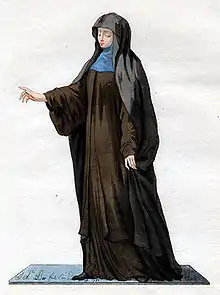
.jpg.webp)

